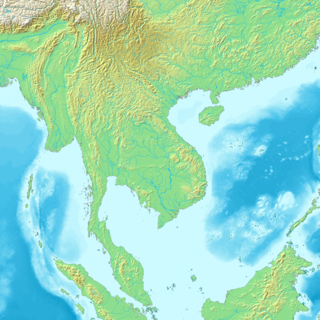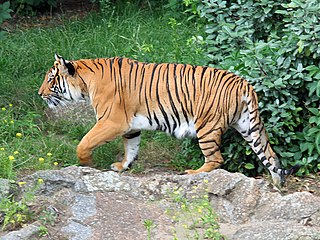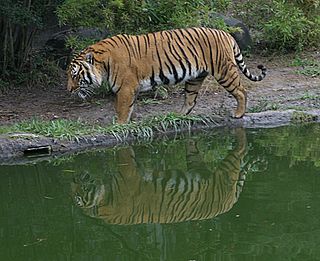
Mainland Southeast Asia is the continental portion of Southeast Asia. It lies east of the Indian subcontinent and south of Mainland China and is bordered by the Indian Ocean to the west and the Pacific Ocean to the east. It includes the countries of Cambodia, Laos, Myanmar, Thailand and Vietnam as well as Peninsular Malaysia.

The subfamily Caprinae, also sometimes referred to as the tribe Caprini, is part of the ruminant family Bovidae, and consists of mostly medium-sized bovids. A member of this subfamily is called a caprine.

The kting voar, also known as the khting vor, linh dương, or snake-eating cow is a bovid mammal reputed to exist in Cambodia and Vietnam. The kting voar's existence as a real species should be regarded as questionable, and it is now thought to simply be a hoax made from water buffalo horns.

The Japanese serow is a Japanese goat-antelope, an even-toed ungulate. It is found in dense woodland in Japan, primarily in northern and central Honshu. The serow is seen as a national symbol of Japan, and is subject to protection in conservation areas.

The Indochinese tiger is a population of the Panthera tigris tigris subspecies that is native to Southeast Asia. This population occurs in Myanmar and Thailand. In 2011, the population was thought to comprise 342 individuals, including 85 in Myanmar and 20 in Vietnam, with the largest population unit surviving in Thailand, estimated at 189 to 252 individuals during the period 2009 to 2014.

The Indochinese Communist Party (ICP) was a political party which was transformed from the old Vietnamese Communist Party in October 1930. This party dissolved itself on 11 November 1945.

The gorals are four species in the genus Naemorhedus. They are small ungulates with a goat-like or antelope-like appearance. Until recently, this genus also contained the serow species.

The mainland serow is a species of serow native to the Himalayas, Southeast Asia and China.

The wildlife of Cambodia is very diverse with at least 162 mammal species, 600 bird species, 176 reptile species, 900 freshwater fish species, 670 invertebrate species, and more than 3000 plant species. A single protected area, Keo Seima Wildlife Sanctuary, is known to support more than 950 total species, including 75 species that are listed as globally threatened on the IUCN Red List. An unknown amount of species remains to be described by science, especially the insect group of butterflies and moths, collectively known as lepidopterans.

The wildlife of Laos encompasses the animals and plants found in the Lao People's Democratic Republic, a landlocked country in southeastern Asia. Part of the country is mountainous and much of it is still clad in tropical broadleaf forest. It has a great variety of animal and plant species.

The serow, is any of four species of medium-sized goat-like or antelope-like mammals in the genus Capricornis. All four species of serow were, until recently, classified under Naemorhedus, which now only contains the gorals.

The red serow, also called the Burmese red serow, is a goat-antelope thought to be native to southern Bangladesh and northern Myanmar. It has been sometimes been considered a subspecies of C. sumatraensis. In the northeastern part of India, the red serow occurs widely in the hills south of the Brahmaputra river. although the IUCN states that this species is recorded with certainty only from Myanmar, in Kachin State, and that records in India refer to the Himalayan serow.Serow in South and Southeast Asia are threatened by habitat destruction, poaching, and disease transmission from domestic livestock. Myanmar and India face severe poaching issues despite legal protections.

The Sumatran serow, also known as the southern serow, is a subspecies of the mainland serow native to mountain forests in the Thai-Malay Peninsula and on the Indonesian island of Sumatra. It was previously considered its own species, but is now grouped under the mainland serow, as all the mainland species of serow were previously considered subspecies of this species. The Sumatran serow is threatened due to habitat loss and hunting, leading to it being evaluated as vulnerable by the IUCN.

The Himalayan serow, also known as the thar, is a subspecies of the mainland serow native to the Himalayas. It was previously considered its own species, as Capricornis thar. It is the official state animal of the Indian state of Mizoram.

The Yamaha XT225, or known in some markets as the Yamaha Serow, was a dual-sport motorcycle produced by Yamaha from 1986 to 2007. The XT225 was preceded and superseded by the XT250. Power is supplied by a 223cc single-cylinder, air-cooled four-stroke engine featuring a SOHC and 2 valves. The engine produces 15 kW of power and 19Nm of torque. The XT225 has a reputation for being a lightweight dual-purpose motorcycle which is suited to many applications.

Khao Chamao - Khao Wong National Park, is a National Park in Khao Chamao District, Rayong Province in Thailand. The park covers an area of 52,300 rai ~ 84 square kilometres (32 sq mi) of forested mountains. North of the national park is the larger Khao Ang Rue Nai Wildlife Sanctuary.

Glischropus bucephalus, the Indochinese thick-thumbed bat, is a species of bat in the family Vespertilionidae. The bat is found in Cambodia, Myanmar, Laos, Thailand and Vietnam north of the Isthmus of Kra.
Phnom Thnout-Phnom Pok Wildlife Sanctuary is a 42,097 ha protected area in northern Cambodia, located in Siem Reap province. The area was formally protected as a wildlife sanctuary in August 2017. The area is supported by Our Future Organization, with the conservation program developing out of the BeTreed ecotourism social enterprise first established in 2013.
Hunting is a popular recreational pursuit, a tourist activity in Cambodia, but mostly still a livelihood for many people in Cambodia.
















